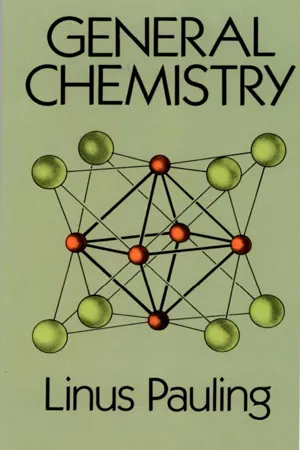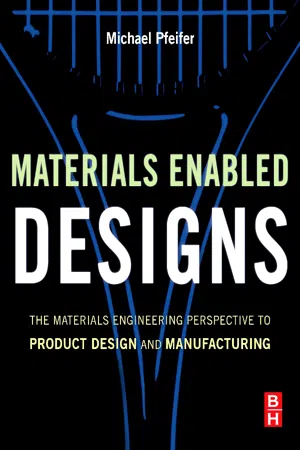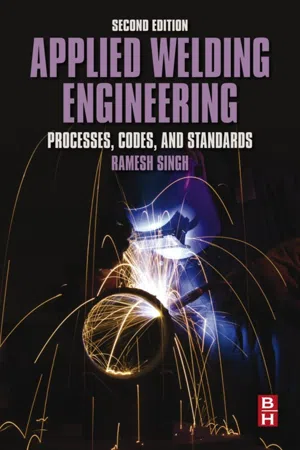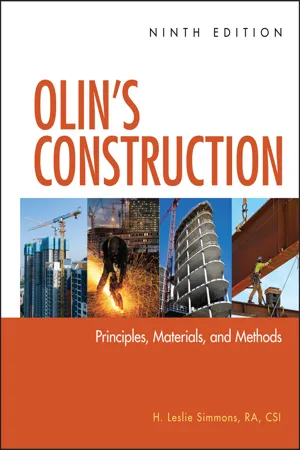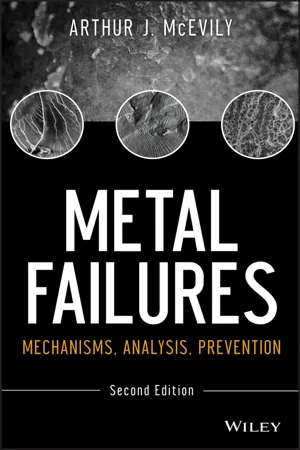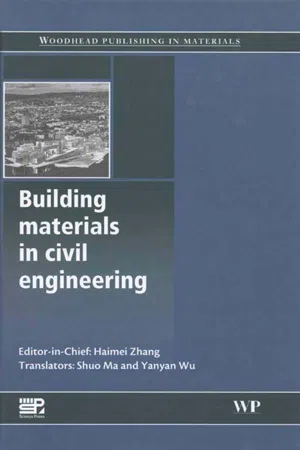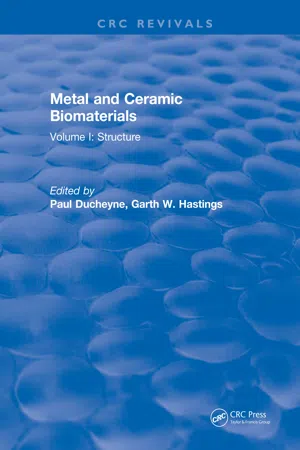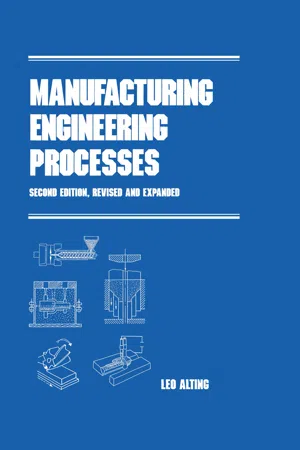Chemistry
Structure, Composition & Properties of Metals and Alloys
Metals are crystalline materials with a close-packed structure, allowing for high ductility and conductivity. Alloys are mixtures of metals or a metal with another element, often designed to enhance specific properties. The properties of metals and alloys, such as strength, conductivity, and corrosion resistance, are influenced by their composition, crystal structure, and defects.
Written by Perlego with AI-assistance
Related key terms
Related key terms
1 of 4
Related key terms
1 of 3
12 Key excerpts on "Structure, Composition & Properties of Metals and Alloys"
- eBook - ePub
- Linus Pauling(Author)
- 2014(Publication Date)
- Dover Publications(Publisher)
17
The Nature of Metals and Alloys
About eighty of the more than one hundred elementary substances are metals. A metal may be defined as a substance that has large conductivity of electricity and of heat, has a characteristic luster, called metallic luster, and can be hammered into sheets (is malleable) and drawn into wire (is ductile); in addition, the electric conductivity increases with decrease in temperature.*17-1. The Metallic Elements
The metallic elements may be taken to include lithium and beryllium in the first short period of the periodic table, sodium, magnesium, and aluminum in the second short period, the thirteen elements from potassium to gallium in the first long period, the fourteen from rubidium to tin in the second long period, the twenty-nine from cesium to bismuth in the first very long period (including the fourteen rare-earth metals), as well as the eighteen from francium to khurchatovium.The metals themselves and their alloys are of great usefulness to man, because of the properties characteristic of metals. Our modern civilization is based upon iron and steel, and valuable alloy steels are made that involve the incorporation with iron of vanadium, chromium, manganese, cobalt, nickel, molybdenum, tungsten, and other metals. The importance of these alloys is due primarily to their hardness and strength. These properties are a consequence of the presence in the metals of very strong bonds between the atoms. For this reason it is of especial interest to us to understand the nature of the forces that hold the metal atoms together in metals and alloys.17-2. The Structure of Metals
In a nonmetal or metalloid the number of atoms that each atom has as its nearest neighbors is determined by its covalence. For example, the iodine atom, which is univalent, has only one other iodine atom close to it in a crystal of iodine: the crystal, like liquid iodine and iodine vapor, is composed of diatomic molecules. In a crystal of sulfur there are S8 molecules, in which each sulfur atom has two nearest neighbors, to each of which it is attached by one of its two covalent bonds. In diamond the quadrivalent carbon atom has four nearest neighbors. On the other hand, the potassium atom in potassium metal, the calcium atom in calcium metal, and the titanium atom in titanium metal, which have one, two, and four outer electrons, respectively, do not have only one, two, and four nearest neighbors, but have, instead, eight or twelve nearest neighbors. We may state that one of the characteristic features of a metal is that each atom has a large number of neighbors; the number of small interatomic distances is greater than the number of valence electrons. - eBook - ePub
Materials Enabled Designs
The Materials Engineering Perspective to Product Design and Manufacturing
- Michael Pfeifer(Author)
- 2009(Publication Date)
- Butterworth-Heinemann(Publisher)
As discussed in the previous chapter, the performance and reliability of a product element depends on the properties of the materials from which it is made. The properties of any material depend on its various features—composition and microscopic structures.The composition of a material refers to the atomic elements and compounds that make up a material. Different elements, mixtures of elements, and compounds have different properties. The intrinsic properties of any material depend on its composition. For example, tin melts at a lower temperature than copper, aluminum oxide is harder than magnesium oxide, and polycarbonate is stronger than polyethylene.The microscopic structure is the manner in which the atoms, molecules, groups of atoms, and groups of molecules arrange themselves within a material. The sizes of microscopic structures cover a wide range, from nanometer scale to millimeter scale. The microscopic structure within a material depends on the following three factors:1. The composition of the material 2. The manufacturing processes used to create the material and form it into a product element 3. The storage and use conditions to which a product element is exposedThe composition and certain microscopic structures can be manipulated as desired to achieve the desired properties of a material. This manipulation is achieved through the manufacturing processes used to create materials and form product elements. Specifically, the thermal, mechanical, electromagnetic, radiation, chemicals, and electrochemical conditions to which a material is exposed during manufacturing influence its microscopic structures. In addition, the use conditions to which a product element is exposed can affect a material's microscopic properties. - eBook - ePub
- Hani M. Tawancy, Anwar Ul-Hamid, Nureddin M. Abbas(Authors)
- 2004(Publication Date)
- CRC Press(Publisher)
7Structure of Engineering Alloys
7.1 Introduction
Modern engineering technology vividly demonstrates the intimate relationship between matter and energy, as well as the vital importance of the structure of matter in design considerations. Of the three states of matter; solid, liquid and gaseous, matter in its solid state dominates the structural and mechanical applications in engineering design. As pointed out in Chap. 1 , the properties of engineering materials are those qualities which determine their usefulness in certain applications. To effectively select and use materials for engineering applications, it is important to have a basic knowledge of the origin of these properties and how they can be controlled. Developing such a knowledge lies within the spectrum of materials science.Most of the technologically important properties of engineering alloys, including mechanical, chemical, and physical properties, are determined by their internal structure. Therefore, an understanding of the principles governing the internal structural features is essential in the selection of the best material or the optimum combination of material and processing for specific engineering applications. Due to the intimate relationship between matter and energy, it is first instructive to review the principles of thermodynamics.7.2 Principles of Thermodynamics
Thermodynamics is the branch of physical science dealing with energy, its conservation and its transformation from one form to another. Just as mechanics introduces mass, length, and time as basic concepts, thermodynamics introduces temperature as a basic concept; it is a measure of thermal or heat energy. By means of some initial statements known as the laws of thermodynamics, it is possible to derive very useful relationships between measurable macroscopic properties of a substance such as temperature, solubility, and equilibrium constant. Such a substance which can either be a solid, liquid, gas, or any combination of these is called a system. - eBook - ePub
Applied Welding Engineering
Processes, Codes, and Standards
- Ramesh Singh(Author)
- 2015(Publication Date)
- Butterworth-Heinemann(Publisher)
Section 1 Introduction to Basic MetallurgyOutlineChapter 1. Introduction Chapter 2. Alloys Chapter 3. Physical Metallurgy Chapter 4. Structure of Materials Chapter 5. Production of Steel Chapter 6. Classification of Steels Chapter 7. Cast Iron Chapter 8. Stainless Steels Chapter 9. Nonferrous Materials Chapter 10. Working with Metals Chapter 11. Mechanical Properties and Testing of Metals Chapter 12. Heat Treatment of SteelsPassage contains an image
Chapter 1Introduction
Abstract
For understanding welding, the knowledge of basic metallurgy is strengthened. The section includes chapters to revise key elements of basic metallurgy as applicable to a welding engineer. The introduces concept of metals and alloys, and introduces to production of iron.Keywords
Process Metallurgy; Physical Metallurgy; Mechanical Metallurgy; Pure metals and alloys; Smelting; Sponge IronWhen we talk of metallurgy as a science of study of metals, the first question that arises is what is a metal? Most of us can recall the introductory study of metals in basic physics in school.Metals are best described by their properties. Metals are crystalline in the solid state. Except for mercury, metals are solid at room temperature; mercury is a metal but in liquid form at room temperature. Metals are good conductors of heat and electricity, and they usually have comparatively high density. Most metals are ductile, a property that allows them to be shaped and changed permanently without breaking by the application of relatively high forces. Metals are elements, and metals are also alloys created by humans in pursuit of specific properties. Aluminum, iron, copper, gold, and silver are examples of metals as elements. Brass, steel, and bronze are examples of alloys, the human-made metals.Metallurgy is the science and technology of metals and alloys. The study of metallurgy can be divided into three general groups.1. Process metallurgy - eBook - ePub
Olin's Construction
Principles, Materials, and Methods
- H. Leslie Simmons(Author)
- 2011(Publication Date)
- Wiley(Publisher)
A material's suitability for a particular use depends on its ability to perform satisfactorily under the conditions to be encountered. When a material's properties are known, its performance in a particular situation can be predicted. The four general groups of properties of interest to those in the construction industry are mechanical, thermal, electrical, and chemical properties. Each depends on the composition of the material in question.The millions of materials in our universe are all made from just three basic building blocks: atoms, ions , and molecules . These are bonded together by one of several basic chemical bonds. Materials can be classified according to these basic structural elements and bonds into three major categories with different properties:1. Ceramics and glasses —hard, brittle, poor conductors of heat and electricity2. Metals —more ductile than ceramics, good conductors of heat and electricity3. Molecular materials —low melting temperatures, fair strength, poor conductors of heat and electricitySince all construction materials fall into one of these three categories, a greater understanding of such materials can be obtained by recognizing the category in which a particular material belongs and remembering the properties of that category. For instance, glass wool and foamed polystyrene may have identical insulating capabilities, but the glass wool falls into the ceramic category and the foam into the molecular category. From that knowledge a designer can surmise, without seeing manufacturers' specifications for the materials, that the foam will have a lower melting temperature than the glass wool, because the melting temperatures of molecular materials is lower than that of ceramic materials .This chapter is intended to expand and sharpen the reader's instinct for categorizing materials. First, the basic structure of matter is discussed; then the four sets of properties that determine a material's performance are considered in some detail. For more information about the properties of a particular material, refer to the chapter in which that specific material is discussed.23.1 Structure of Matter Matter is formed by the chemical bonding of atoms, ions, and molecules. The particular combination of components and bonding methods determines final material properties. - Arshad Ahmed, John Sturges(Authors)
- 2014(Publication Date)
- Routledge(Publisher)
E . The high value of Young’s modulus is one of the major advantages of steel as a structural material. A metal’s elastic modulus is a fundamental property of the metal, and its physical basis lies in the crystalline structure of the metal, and in the nature and strength of the bonds between the atoms in the metal’s crystal lattices.Metals also possess excellent electrical and thermal conductivities , particularly FCC metals (see below) such as copper and aluminium. These are properties that we can make use of in heat exchangers, central heating systems and in the provision of lighting systems and numerous electrical goods used in buildings. We therefore need to gain an insight into the properties of metals and the reasons for them. We shall find that all these properties arise from the highly ordered, crystalline structures found in metals and alloys.In the previous chapter we have examined the nature of atomic bonding, and we have seen how metals as a class have very ordered, crystal structures. In the next chapter we shall examine in more detail the mechanical properties of materials, and it is the task of this chapter to examine in simple terms how the mechanical and physical properties of metals, including those mentioned above, are a consequence of their crystalline nature.3.2 Crystalline structure of metals
Metals are crystalline , that is to say their atoms are arranged in patterns with the highest degree of symmetry and order of any of the materials used by man. Their properties, including their strength and ductility, their excellent thermal and electrical conductivities all arise from their crystallinity. We shall therefore examine the crystal structures of the metals commonly used in construction. The bonding between the atoms that make up metal crystals is also special, and is known as the metallic bond . We have examined the various types of bonds between atoms in Chapter 2 , and we have seen that chemical bonding involves the extra-nuclear structure of atoms, i.e. the electronic structure. The atomic nucleus in all elements is orbited by electrons, the number of electrons depending on which element it is, i.e. what the atomic number- eBook - ePub
Metal Failures
Mechanisms, Analysis, Prevention
- Arthur J. McEvily, Jirapong Kasivitamnuay(Authors)
- 2013(Publication Date)
- Wiley-Interscience(Publisher)
Chapter 5 Alloys and Coatings I. Introduction The characteristics of the materials involved in a failure are obviously of importance in carrying out a failure analysis. This chapter reviews the microstructural features and related matters, such as equilibrium and isothermal transformation diagrams of some of the more common alloys, as influenced by alloying and heat treatment. The nature of the coatings used in high-temperature applications is also discussed. II. Alloying Elements Figure 5-1 shows the periodic table of the elements. In solid form the elements are characterized by their crystal structure, with the elements considered to be ordered arrays of hard spheres. The three principal crystal structures are the face-centered cubic (fcc) with four atoms per unit cell, as in the case of aluminum and copper; the hexagonal close-packed (hcp) with six atoms per unit cell, as in the case of zinc and magnesium; and the body-centered cubic (bcc) with two atoms per unit cell, as in the case of iron. The unit cells of these crystal structures are shown in Fig. 5-2. If no atom is present on a lattice site, then a point defect, known as a vacancy, exists. Vacancies are important agents in diffusion processes, as we shall see. The yield strength of a pure element is usually quite low and unsuitable for structural application. A combination of elements is known as an alloy. The main purpose in alloying is to increase the strength properties. Additional reasons for alloying include the improvement in corrosion resistance, wear properties, and performance at elevated temperatures. There are other reasons for alloying as well. For example, if sulfur is present in a steel, during heat treatment the sulfur atoms may diffuse to the grain boundaries and cause temper embrittlement - eBook - ePub
- Haimei Zhang(Author)
- 2011(Publication Date)
- Woodhead Publishing(Publisher)
2The Basic Properties of Building Materials
This chapter discusses the components, the structures of materials and the influence of their compositions on the properties; it emphasizes on the physical properties and the mechanical properties of materials; and also it introduces the decorativeness and the durability of materials.In the civil engineering, building materials plays different roles, so they should possess corresponding properties. For example, structural materials should have good mechanical characteristics; waterproof materials should be impermeable and water-resistant; wall materials should be heat-insulating and sound-absorbing. In addition, building materials should be durable because they often affected by various external factors, such as wind, rain, sun and frost.The basic properties of building materials include physical property, mechanical property, durability and decorativeness. The commonness of the properties is discussed in this chapter and their specialties will be discussed in relevant chapters.2.1 Compositions and Structures of Materials and the Influence of Their Constructions on the Properties
2.1.1 The Compositions of Materials
The compositions of materials include chemical compositions and mineral compositions which are the key factors for the properties of materials.1 Chemical Composition
The chemical composition refers to the chemical constituents. Various chemical compositions result in different properties. For example, with the increase of carbon content, the strength, hardness and toughness of carbon steel will change; carbon steel is easy to rust, so stainless steel comes into being by adding chromium, nickel and other chemical components into steel.2 Mineral Composition
Many inorganic non-metallic materials consist of a variety of mineral compositions. Minerals are monomers and compounds with a certain chemical components and structures. The mineral compositions are the key factors for the properties of some building materials (such as natural stone, inorganic gel and other materials). Cement reveals different characteristics because of different clinkers. For example, in Portland cement clinkers, the condensation hardening is fast and the strength is high when the content of tricalcium silicate—the clinker mineral—is high. - eBook - ePub
- Ahmad Hemami(Author)
- 2017(Publication Date)
- CRC Press(Publisher)
We may say elements are single materials that are not composed of separable substances. The number of known elements so far, as they appear in the Mendeleev table (periodic table of elements) is 118, and depending on the way and the magnitude they can combine together, they can compose millions of materials. The Mendeleev table as shown in Figure 3.1 contains various information about all elements. All other materials that we observe, i.e. those not in the Mendeleev table, are Figure 3.1 Mendeleev periodic table of the elements. (Copyright CRC Press.) compounds and are made up of two or more elements chemically bonded together. Going inside the elements has shown that they are all made out of only a few components. In this chapter, we are going to study this matter and see how electricity is related to the inside structure of the materials and how so many materials with various properties can be electrically categorized. 3.2 Material Properties Before getting into the basic structure of all materials, we can easily recognize that there are noticeable differences between various materials as we look around us. Consider, soil, wood, plastic, cloth, a piece of iron, gold, and aluminum. We can define the similarities and the differences between them. All the metals can be categorized as shiny, solid (except mercury that at normal temperature is in the form of liquid), and relatively heavier than many other materials. Moreover, they are conductors of heat. That is, if one side of a reasonably long piece of metal is heated, the heat moves to the other side. This is not true for cloth, wood, or plastic. One more difference between the above-named metals and the rest of the materials is that all the metals are among the elements, whereas others (e.g., cloth, wood, and plastic) are nonelements or compound materials. Elements are those seen in the Mendeleev table. Everything else is a compound, made out of some elements - eBook - ePub
- Sankara Papavinasam(Author)
- 2013(Publication Date)
- Gulf Professional Publishing(Publisher)
Metals are not one large crystal made up of periodic arrangement of unit cells, but rather are made up of several crystals randomly oriented with respect to one another. These clusters of crystals are known as grains. The boundaries between the grains are known as grain boundaries. The atoms are not in their proper places in grain boundaries because the periodic nature of the grain formation has been disrupted. Because of this different orientation of the atomic structures, the properties of grain boundaries are different from those of grains.The study of the structure of metals, i.e., the study of grains and grain boundaries by optical microscopy is called metallography. Standards providing guidelines on terminology related to metallography include:• ASTM E7, ‘Terminology Relating to Metallography’In general, as the number of grain boundaries increases (consequently as the grain size decreases) the mechanical properties (strength, ductility, and toughness) improve, but chemical and corrosion resistance decrease. Grain boundaries have higher energy than the grains, hence are preferentially attacked by chemicals.Most pure metals do not possess the properties (mechanical strength, chemical resistance, and corrosion resistance) necessary for engineering applications. Therefore other elements are introduced into the metal to provide these. A combination of two or more elements in which at least one of the elements is a metal is called an alloy or solid solution. In an alloy, the parent metal is the solvent and the alloying element is the solute. If the solute element is small (e.g., carbon, nitrogen, or hydrogen) the energetically favorable situation is one in which the solute element occupies the interstitial positions; i.e., the alloying elements occupy the interstitial holes between the parent metal atoms (Figure 3.4 (A)).4 The resulting alloy is known as interstitial solid solution. If the solute element is large (e.g., chromium, nickel, or manganese) then it will substitute the atom of the parent metal. The resulting alloy is known as substitutional solid solution (Figure 3.4 (B)).4 - eBook - ePub
Metal and Ceramic Biomaterials
Volume II: Strength and Surface
- Ducheyne(Author)
- 2018(Publication Date)
- CRC Press(Publisher)
Chapter 2 Structural Characteristics of Metals and Ceramics G. Heimke TABLE OF CONTENTS- Introduction
- Some Preliminary Remarks About Solids
- The Atom
- The Compounds
- The Solids
- The Different States of Matter, Phases, and Phase Diagrams
- Basic Properties of Solids
- Solubility and Corrosion
- Electronic Energy Distribution in Solids
- Metals
- The Characteristic Properties of Metals
- Electric Conductivity
- Fleat Conductivity
- Reflectivity of Metals
- Plasticity of Metals and Work Hardening
- The Main Phases of Metals
- Alloys
- The Characteristic Properties of Metals
- Ceramics
- Oxide Ceramics
- Nonoxide Ceramics
- Carbons
- Glasses and Glass Ceramics
- Multicomponent Ceramics
- Ceramic Technology
- Characteristic Properties of Ceramics
- Conclusions
I. Introduction
The attempt to describe the basic properties of solids like metals and ceramics in close relation to their structures can start from different levels of information and knowledge about the essential features of the existence of matter. In order to achieve one unique common status, first, some simple and general information on atoms and ions and their interactions in compound formation is repeated. Solids are, then, introduced as “giant molecules”. The different kinds of bonds existing in compound formation are followed further on into the field of solids where the basic properties distinguishing metals and ceramics are traced back to the kinds of binding processes prevailing in either of these two materials.The concepts of solubility and corrosion are dealt with in some more detail because of their fundamental importance of material selection for implant application. Because of the steadily rising attention which electron exchange or redox processes is gaining for the interpretation and understanding of different kinds of biocompatibility, some basic concepts of the band theory of semiconductors are mentioned. - Alting(Author)
- 2020(Publication Date)
- CRC Press(Publisher)
In forming from the liquid material state, the final material properties depend mainly on the composition (including solidification temperature range), the thermal and mechanical properties of the molding or die material, and the solidification conditions (direction, rate, etc.). In forming from the solid material state by plastic deformation, the amount of deformation, the temperature, and the rate of deformation primarily determine the final properties. Cold deformation increases the strength and decreases the ductility of the material. Hot deformation gives poor surface quality and reasonably good mechanical properties. Solid-state forming by machining (mass-reducing processes) primarily influences the surface properties (roughness, hardness, internal stresses, etc.). The examples mentioned only serve to illustrate the complexity of the evaluation of the final material properties of a component. These problems are discussed in more detail in some of the later chapters.3.4 CLASSIFICATION OF MATERIALS
As mentioned previously, it is very difficult to provide broad information regarding all the important engineering materials in this context. Consequently, only a general survey will be given to allow a rough evaluation of the suitability of the different material groups for various processes. From this survey and the process descriptions in the later chapters, a reasonable background for the evaluation of the final properties of the materials will be available.Engineering materials can be divided into groups showing important relationships. In this context the traditional classification shown in Fig. 3.1 will be followed.The main groups are metallic materials, nonmetallic materials, and composite materials. Composite materials are built up from two or more materials, so that new and special properties are obtained. Metallic materials are subdivided into ferrous and nonferrous metals. The nonmetallic materials are subdivided into polymers, ceramics, and glasses, but the group covers many other materials (wood, concrete, bricks, etc.) that are not important for the present discussion.FIGURE 3.1 Classification of some of the engineering materials.3.5 METALLIC MATERIALS
3.5.1 Bonding and Structure
Metals are characterized by the metallic bonding , where the metal ions are held together by an “electron cloud.” This type of bonding has a high mobility of the free (valence) electrons and accounts in general for the high strength level, the ductility (ability to be deformed without fracture), and the relatively high melting temperature of metals. These general tendencies can be influenced by many factors; consequently, exceptions are common.Metals have a crystalline structure with predominantly body-centered cubic, face-centered cubic, or close-packed hexagonal lattice structures. Crystalline materials normally consist of thousands of small individual crystals or grains, depending on the production method. During solidification, many individual lattices begin to form at various points within the melt. As solidification proceeds these crystals or grains, which have random orientation, grow, meet, and form the grain boundaries (Fig. 3.2
Index pages curate the most relevant extracts from our library of academic textbooks. They’ve been created using an in-house natural language model (NLM), each adding context and meaning to key research topics.
Explore more topic indexes
Explore more topic indexes
1 of 6
Explore more topic indexes
1 of 4
